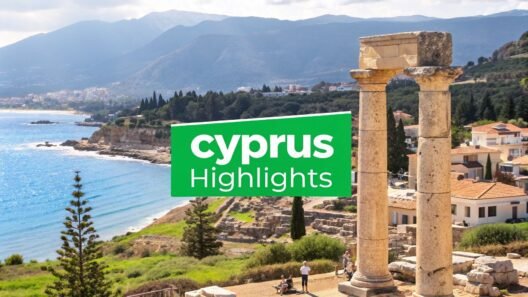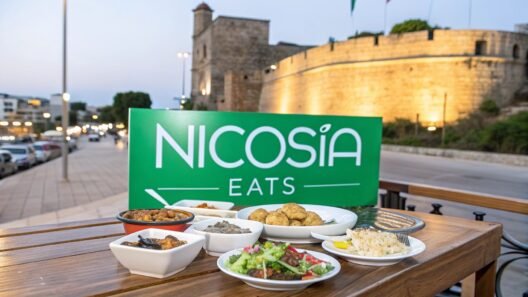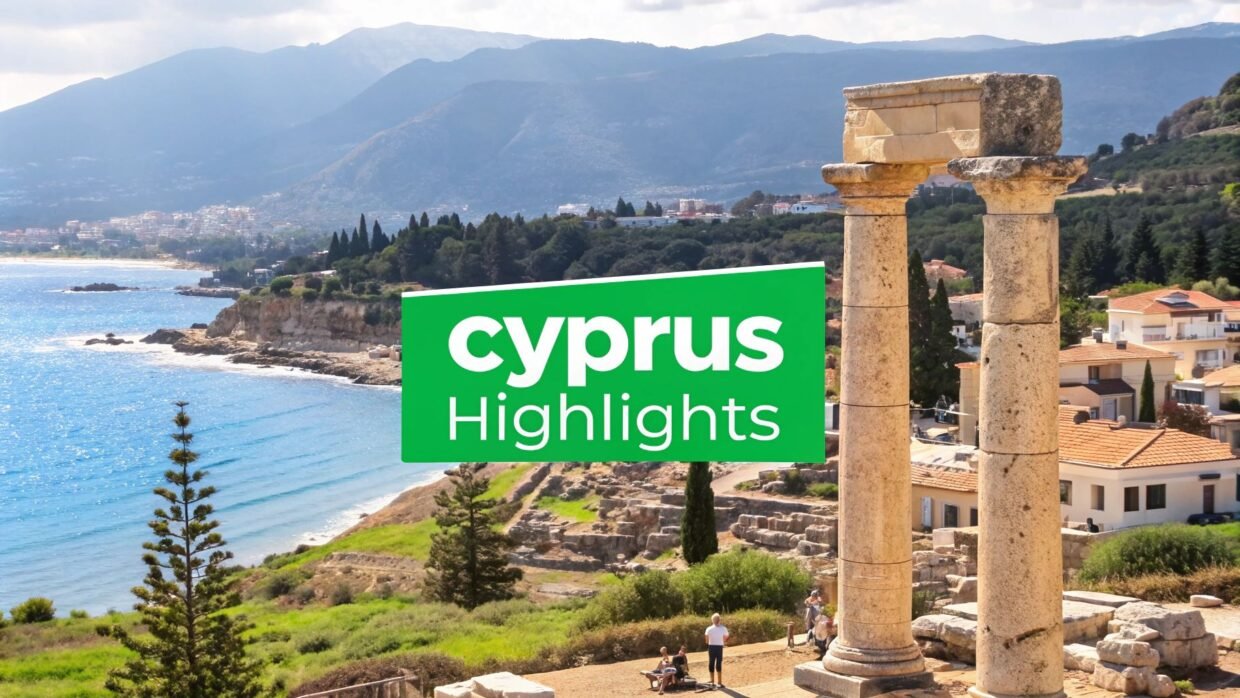Welcome to an island where ancient myths whisper on the sea breeze and history is etched into every stone. Cyprus, a jewel of the Mediterranean, offers more than just sun-drenched beaches; it's a land of profound contrasts, from the cool, pine-scented Troodos Mountains to the vibrant, sun-baked coastlines. This guide is your curated journey through the most essential Cyprus points of interest, designed for the discerning traveller seeking both relaxation and adventure.
We move beyond the typical tourist trails to uncover the stories, sights, and insider secrets that make this island truly unforgettable. Our goal is to provide a practical and comprehensive resource, equipping you with the actionable information needed to explore with confidence. Forget generic overviews; this listicle delves into the specifics, offering tips on the best times to visit, what to look for, and how to experience each location like a local.
From the breathtaking mosaics of the Paphos Archaeological Park to the poignant history of the Green Line in Nicosia, each destination has been chosen to showcase the island's diverse character. You'll discover ancient Roman theatres perched above the sea, serene monasteries nestled in mountain forests, and rugged peninsulas teeming with wildlife. This article organises these remarkable sites into a clear, easy-to-navigate format, ensuring you can plan your itinerary efficiently. Whether you're a history aficionado drawn to ancient ruins, a nature lover eager to hike pristine trails, or simply in search of cultural immersion, prepare to explore the very soul of Cyprus. We have meticulously selected these ten destinations to provide a comprehensive and enriching experience of this beautiful island.
1. Paphos Archaeological Park
A sprawling open-air museum and UNESCO World Heritage Site, the Kato Paphos Archaeological Park is arguably one of the most significant Cyprus points of interest. Located near the old harbour, this vast site contains monuments from prehistoric times through to the Middle Ages, with the majority of its most famous remains dating to the Roman period. It offers an unparalleled window into the lavish lifestyles of Roman provincial governors and nobility.
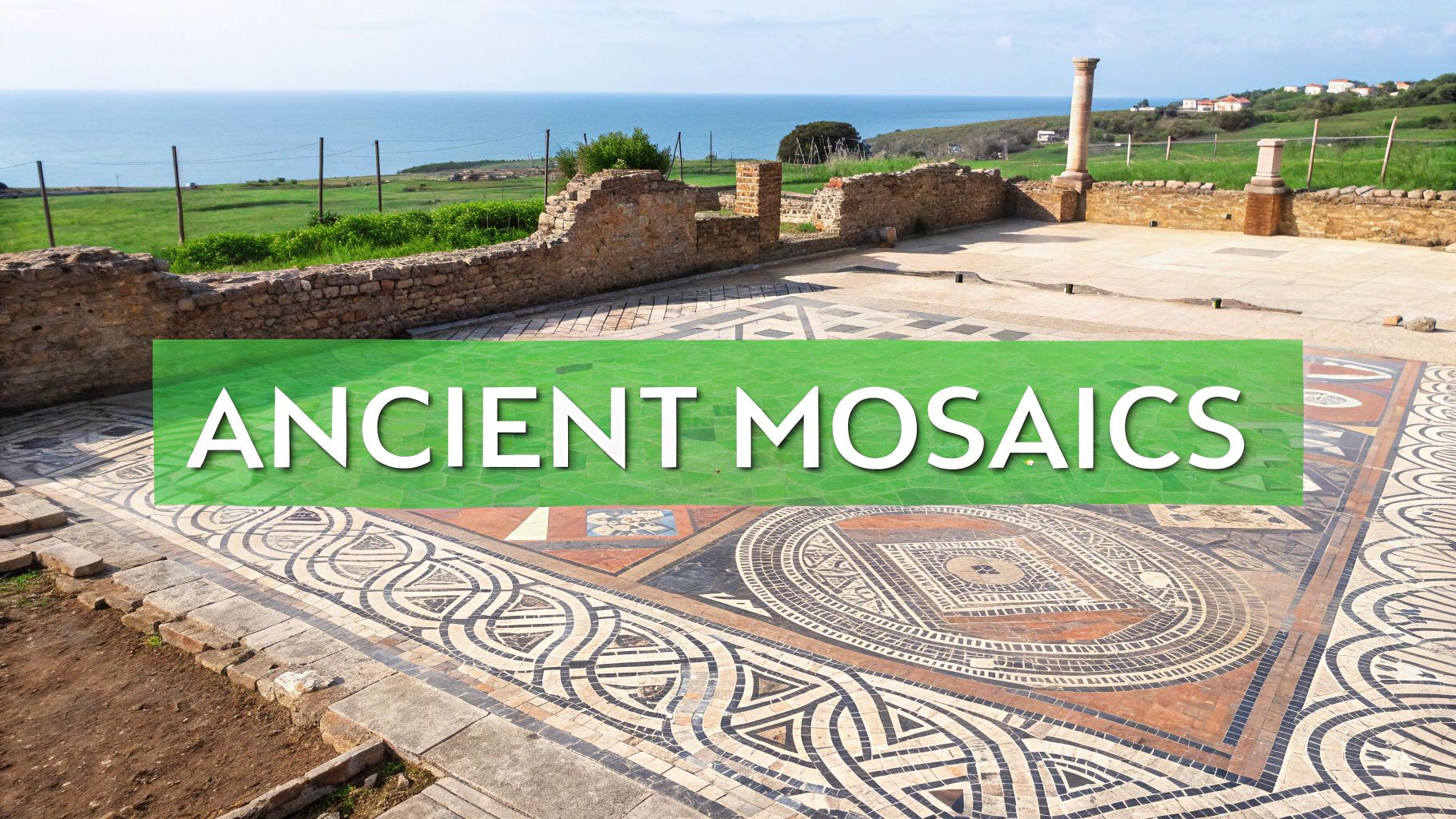
The park’s main draw is its collection of extraordinarily well-preserved mosaic floors, particularly within the four Roman villas: the House of Dionysus, the House of Orpheus, the House of Aion, and the House of Theseus. These intricate artworks depict elaborate scenes from Greek mythology, showcasing incredible craftsmanship and artistic detail that have survived for nearly two millennia. Beyond the villas, the site also includes the ruins of an ancient Odeon (a small theatre), an Agora (marketplace), and the Saranta Kolones, a fortress built by the Lusignans in the 13th century.
Insider Tips for Visiting
To make the most of your visit to this expansive historical site, consider the following practical advice:
- Timing is Key: Arrive when the park opens, typically around 8:30 am. This allows you to explore the most popular mosaics before the midday heat becomes intense and tour groups arrive.
- Essential Gear: The terrain is uneven and exposed. Comfortable walking shoes are non-negotiable, as are a wide-brimmed hat, sunglasses, and high-SPF sun cream. Bringing a large bottle of water is also highly recommended.
- Maximise Your Understanding: While signs provide basic information, the historical context is vast. Hiring a licensed guide at the entrance or using a detailed guidebook can transform your visit from a simple walk among ruins into a fascinating historical journey.
- Pace Yourself: Allocate at least three to four hours for a thorough exploration. The site is much larger than it first appears, and rushing through means missing out on hidden details and the sheer scale of the ancient city. For more details on what to see in the area, you can learn more about Paphos's must-visit locations.
2. Kyrenia Castle (Girne Castle)
Dominating the picturesque old harbour, Kyrenia Castle (Girne Kalesi) is a magnificent fortress and one of the most iconic Cyprus points of interest. With origins dating back to the Byzantines in the 7th century, the castle was significantly remodelled and fortified by the Lusignans and later by the Venetians in the 16th century, creating the imposing structure seen today. Its formidable walls encircle a fascinating complex of chapels, dungeons, and former living quarters, offering a journey through centuries of the island's turbulent history.
The castle's most prized attraction is the Shipwreck Museum, which houses the remarkably preserved remains of a 4th-century BC Greek merchant ship. Discovered by divers in 1965, the Kyrenia Ship is the oldest trading vessel ever recovered from the seabed, displayed alongside its original cargo of wine amphorae and millstones. Visitors can also climb the Venetian towers for breathtaking panoramic views of Kyrenia's harbour and the turquoise Mediterranean Sea, providing an unforgettable photographic opportunity and a real sense of the fortress's strategic importance.
Insider Tips for Visiting
To get the most out of your exploration of this historic landmark, keep these practical tips in mind:
- Start with the Shipwreck: Head to the Shipwreck Museum first upon arrival. This helps you avoid the larger tour groups that often save it for last, allowing for a more intimate and uncrowded viewing experience.
- Sturdy Footwear is a Must: The castle grounds include ancient, uneven stone steps and ramparts. Comfortable, sturdy shoes are essential for safely navigating the various levels and towers.
- Golden Hour Photography: Plan your visit for the late afternoon. The softer light of the "golden hour" beautifully illuminates the castle's stone walls and the harbour below, creating much better conditions for photography.
- Time Your Tour: Allow a solid two to three hours to explore the castle thoroughly. This gives you enough time to see the museum, climb the ramparts, discover the dungeons, and absorb the history without feeling rushed.
3. Troodos Mountains
Offering a dramatic contrast to the sun-drenched coastline, the Troodos Mountains are the green heart of Cyprus and an essential point of interest for nature lovers and culture seekers. This sprawling mountain range, whose highest peak Mount Olympus reaches 1,952 metres, is a cool, fragrant haven of pine-scented air, winding roads, and timeless villages. It provides a refreshing escape from the coastal heat, particularly in the summer, revealing a different, more traditional side of Cypriot life.
The region is famous for its stunning natural beauty, with cascading waterfalls, nature trails, and dense forests of black pine and cedar. It is also a centre of deep cultural and religious heritage, home to ten UNESCO-listed Byzantine churches and monasteries adorned with vibrant, centuries-old frescoes. Villages like Omodos, Platres, and Kakopetria charm visitors with their cobbled streets, traditional stone houses with wooden balconies, and welcoming tavernas serving authentic mountain cuisine. The area is also a significant wine-producing region, known as the 'krasochoria' or wine villages.
Insider Tips for Visiting
To fully appreciate the natural and cultural wealth of the Troodos range, keep these practical tips in mind:
- Village Hopping: Don't just drive through. Stop in traditional villages like Omodos to sample local wine and 'arkatena' bread, or visit Platres for a walk to the Caledonia Falls. For a more comprehensive guide, you can discover more about the charming Troodos Mountains villages.
- Dress in Layers: Even on a hot day at the coast, temperatures in the mountains can be significantly cooler, especially at higher altitudes. Bringing a light jacket or jumper is always a wise decision.
- Cultural Respect: When visiting the historic monasteries, such as the famous Kykkos Monastery, remember to dress modestly. This means covering your shoulders and knees; shawls and long trousers are often provided at the entrance for visitors.
- Driving Caution: The mountain roads are scenic but can be narrow and winding. Drive slowly, be prepared for sharp turns, and enjoy the breathtaking views safely. In winter, check road conditions as snow is common.
4. Ayia Napa
Once a quiet fishing village, Ayia Napa has transformed into one of the Mediterranean's most famous resort towns, renowned for its stunning sandy beaches and vibrant atmosphere. Located on the southeastern coast of Cyprus, it is a premier destination that masterfully blends natural beauty with lively entertainment. The area is celebrated for its crystal-clear turquoise waters and long stretches of golden sand, making it an essential Cyprus point of interest for sun-seekers and holidaymakers.
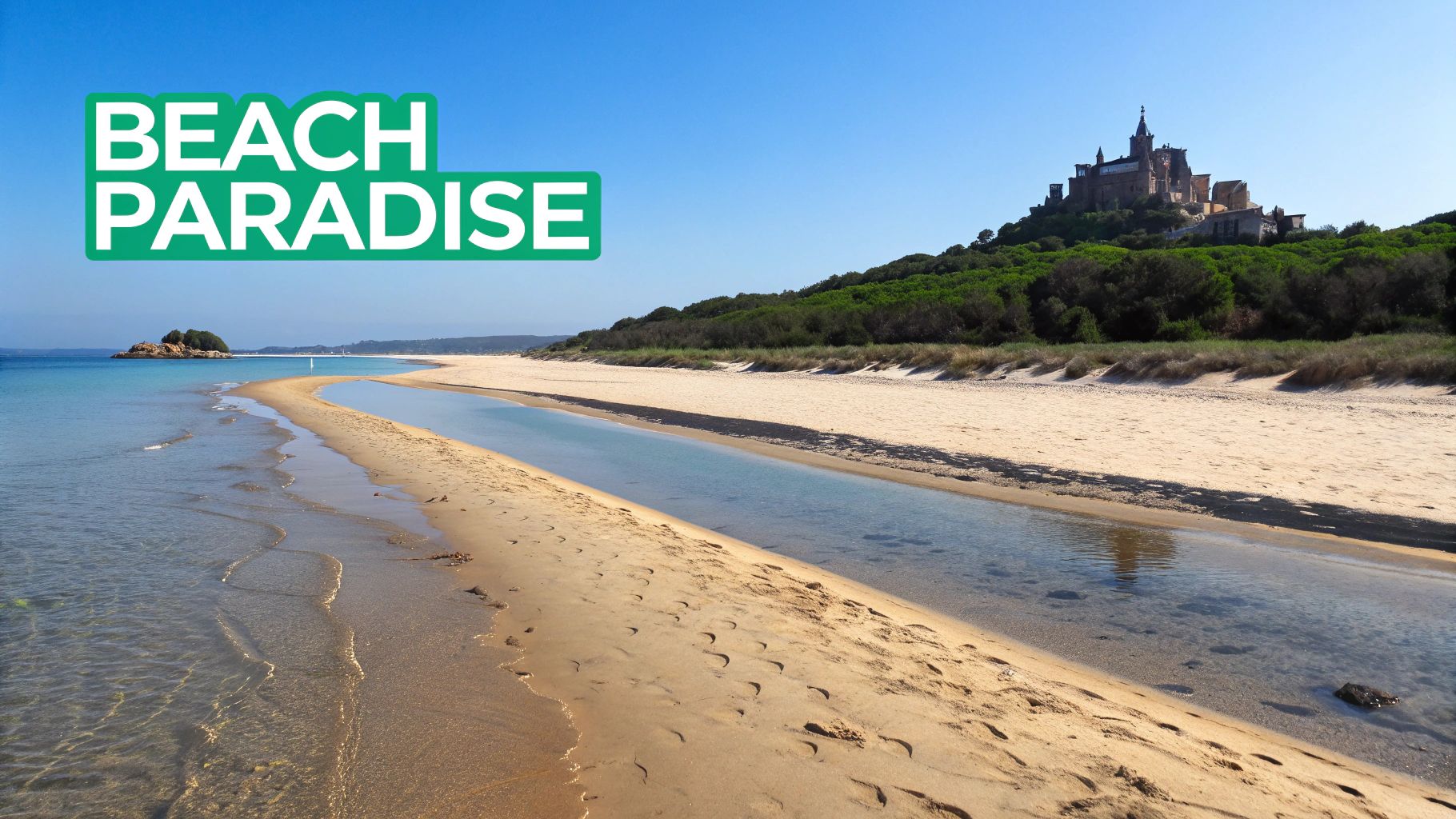
While its nightlife is legendary, Ayia Napa offers much more. At the heart of the town lies the historic Ayia Napa Monastery, a serene 16th-century Venetian-era landmark that provides a peaceful contrast to the bustling streets. The coastline is dotted with world-class beaches, from the iconic Nissi Beach to quieter, family-friendly coves. The area is also a hub for water sports, offering everything from jet skiing and parasailing to scuba diving in the clear coastal waters. Whether you are looking for relaxation, history, or adventure, Ayia Napa provides a complete holiday experience.
Insider Tips for Visiting
To get the most from your trip to this popular coastal resort, keep these practical suggestions in mind:
- Best Time to Visit: For pleasant weather and fewer crowds, plan your trip for May, June, or September. You'll enjoy the sunshine without the peak summer intensity.
- Secure Your Spot: The most popular beaches fill up quickly. Arrive before 10:00 am to secure a prime sun lounger and umbrella, especially at Nissi Beach.
- Explore Quieter Shores: For a more tranquil experience, venture to smaller beaches like Makronissos or Vlychia. They offer the same beautiful sand and sea but with a more relaxed vibe. For a complete guide, explore the best beaches Ayia Napa has to offer.
- Cultural Respite: Visit the Ayia Napa Monastery in the morning. This allows you to appreciate its tranquil atmosphere before the daytime crowds gather in the central square.
- Water Sports Timing: If you plan on trying any water sports, rent your equipment early in the day. The sea is often calmer in the morning, providing better conditions for activities like paddleboarding or kayaking.
5. Kourion Archaeological Site
Perched dramatically on a coastal cliff with commanding views of the Mediterranean Sea, the Kourion Archaeological Site is a spectacular ancient city-kingdom near Limassol. This magnificent site, one of the most important Cyprus points of interest, showcases a seamless blend of Hellenistic, Roman, and early Christian history. Its ruins narrate a story spanning from the Neolithic period to its eventual decline after earthquakes in the 4th century AD.
The centrepiece of Kourion is its beautifully restored Greco-Roman theatre, which is still used today for open-air musical and theatrical performances. Beyond the theatre, visitors can explore the intricate and well-preserved mosaic floors of several Roman villas, such as the 'House of Eustolios', the 'House of Achilles', and the 'House of the Gladiators'. The site also contains the remains of a grand Roman Forum (Agora), Nymphaeum, and an early Christian Basilica, offering a comprehensive look into ancient urban life. The nearby Sanctuary of Apollo Hylates, just a short drive away, was one of the main religious centres of ancient Cyprus and is an essential part of the Kourion experience.
Insider Tips for Visiting
To get the most out of your exploration of this historically rich and scenic location, keep these tips in mind:
- Optimal Timing: Plan your visit for the late afternoon. The lower angle of the sun casts a beautiful golden light on the ruins, making for stunning photographs and a more comfortable temperature for walking.
- Essential Comforts: The site is vast and exposed to the elements. Sturdy, comfortable walking shoes are a must, along with a hat, sunglasses, and high-factor sun cream. Always carry plenty of water, especially during the hot summer months.
- Plan Your Route: Allocate at least two to three hours to explore the main site thoroughly. Don’t forget to include a visit to the nearby Sanctuary of Apollo, which is covered by the same entrance ticket but requires a separate, short drive.
- Avoid the Midday Sun: The heat can be punishing between noon and 3 pm, particularly from June to September. Exploring during these hours can be exhausting and detract from the experience. An early morning or late afternoon visit is far more pleasant.
6. Larnaka Salt Lake
A stunning natural landmark and one of the most important wetland ecosystems in Europe, the Larnaka Salt Lake is a captivating network of four interconnected lakes. Located southwest of Larnaka city, this unique saline habitat offers a mesmerising landscape that transforms dramatically with the seasons. During the hot summer months, the water evaporates completely, leaving a thick, glistening crust of salt, while in winter, the lakes fill with water, creating a haven for migratory birds.
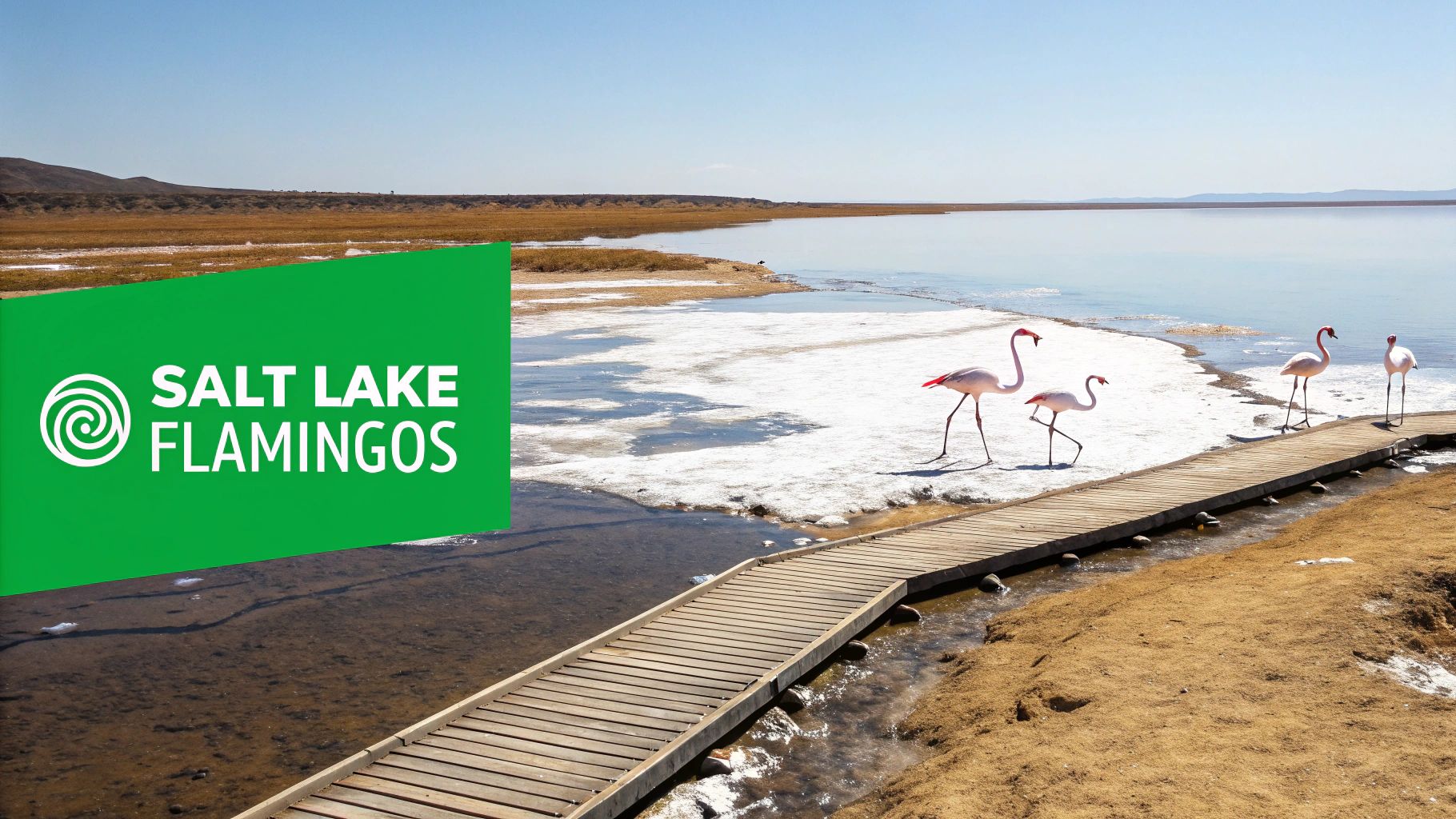
The lake's main attraction is the magnificent spectacle of thousands of Greater Flamingos that use it as a wintering ground. From November to March, these elegant pink birds wade through the shallow waters, feeding on brine shrimp, creating an unforgettable sight for nature lovers and photographers. The area is a protected Ramsar and Natura 2000 site, supporting diverse birdlife beyond flamingos, including wild ducks and other waders. On the bank of the lake also sits the Hala Sultan Tekke, an important Islamic shrine, adding a layer of cultural and historical significance to the serene natural scenery.
Insider Tips for Visiting
To fully appreciate the beauty and wildlife of Larnaka Salt Lake, keep these practical suggestions in mind:
- Time Your Visit for Flamingos: For guaranteed flamingo sightings, plan your trip between November and February. The birds are most active during these cooler, wetter months.
- Best Lighting and Conditions: The most magical time to visit is during the early morning or late afternoon. The low sun casts a golden glow over the water, providing perfect conditions for photography and a more peaceful experience.
- Come Prepared: A good pair of binoculars is essential for getting a closer look at the flamingos and other bird species without disturbing them. Comfortable walking shoes are also a must for exploring the walking trail that circuits the lake.
- Seasonal Considerations: In summer, the heat can be extreme, so avoid visiting during midday. During the warmer, wetter periods, insect repellent can be useful, especially around dusk.
7. Old Town Nicosia (Lefkosia)
As the world's last divided capital, Old Town Nicosia, or Lefkosia, offers a truly unique and poignant experience among Cyprus points of interest. Encased within impressive 16th-century Venetian walls, this historic heart of the island is split by the UN-patrolled "Green Line," separating the Republic of Cyprus from the Turkish-occupied north. Its labyrinthine streets are a living museum, showcasing a complex tapestry of Byzantine, Lusignan, Venetian, and Ottoman history at every turn.
Exploring the Old Town reveals a city of fascinating contrasts. On the southern side, you can wander down the bustling Ledra Street, filled with modern shops and cafes that lead directly to the checkpoint. Nearby, you'll find historic churches, the excellent Leventis Municipal Museum, and beautifully restored neighbourhoods like Laiki Geitonia. Crossing the checkpoint into the northern part unveils a different atmosphere, with landmarks such as the magnificent Selimiye Mosque (formerly the Cathedral of Saint Sophia) and the Büyük Han, a beautifully preserved Ottoman-era caravanserai that now houses artisan shops and cafes.
Insider Tips for Visiting
To fully appreciate the layered history and culture of Nicosia's Old Town, keep these practical tips in mind:
- Gain Perspective First: Start your visit at the Shacolas Tower Museum and Observatory. The panoramic view from the 11th floor provides an invaluable geographical and political context, clearly showing the Venetian walls and the path of the Green Line.
- Essential Documentation: To cross the Green Line checkpoint on Ledra Street, you will need to present a valid passport or national ID card (for EU citizens). The process is usually quick and straightforward.
- Guided Insight: The city's history is incredibly complex. Hiring a licensed local guide can provide profound insights into the "Cyprus Problem" and the stories behind the landmarks, transforming your walk from a simple tour into a meaningful educational experience.
- Respectful Exploration: Remember you are visiting an area with a sensitive political history. When visiting religious sites like churches and mosques, dress modestly, covering your shoulders and knees.
- Allocate Ample Time: Give yourself at least four to five hours to explore both sides of the Old Town without rushing. This allows enough time to see the main sights, browse the markets, and enjoy a traditional coffee or meal.
8. Akamas Peninsula
A vast, unspoiled wilderness of raw natural beauty, the Akamas Peninsula is one of the most breathtaking Cyprus points of interest. Located on the island's northwestern tip, this largely inaccessible and protected area offers a dramatic landscape of rugged coastlines, deep gorges, secluded sandy bays, and unique biodiversity. As a designated national park, it serves as a crucial sanctuary for rare flora and fauna, including endangered sea turtles that nest on its pristine beaches.
The peninsula is a paradise for adventurers and nature lovers, offering some of the best hiking and off-road driving on the island. Key highlights include the famous Baths of Aphrodite, a natural grotto where the goddess of love is said to have bathed, and the stunning Blue Lagoon, whose turquoise waters are perfect for swimming and snorkelling. The Avakas Gorge offers a challenging but rewarding trek through towering limestone walls, while Lara Bay is a protected and vital nesting ground for Green and Loggerhead turtles. This region represents the wild, untamed heart of Cyprus.
Insider Tips for Visiting
To safely and fully experience the wild beauty of the Akamas Peninsula, careful planning is essential. Consider this practical advice for your adventure:
- Vehicle is Key: Standard rental cars cannot handle the peninsula's rugged tracks. Rent a 4×4 vehicle or a quad bike for the freedom to explore independently. Alternatively, organised jeep safari tours are a safe and informative option.
- Essential Gear: The terrain is exposed with very little shade. Comfortable, sturdy hiking shoes are non-negotiable, as are a wide-brimmed hat, high-SPF sun cream, and sunglasses. Pack far more water than you think you will need.
- Time Your Visit: Visit during the spring (March to May) to see the landscape covered in a spectacular blanket of wildflowers and to enjoy pleasant hiking temperatures. To avoid crowds at the Baths of Aphrodite, arrive early in the morning.
- Respect Nature: You are a guest in a protected nature reserve. Stick to marked trails, do not disturb wildlife, and never touch turtle nests or hatchlings. Take all of your rubbish with you to preserve the area's pristine condition.
9. Kykkos Monastery
Perched high in the Troodos Mountains at an altitude of 1,318 metres, the Holy Royal and Stavropegic Monastery of Kykkos is one of the wealthiest, most lavish, and most important religious sites in Cyprus. Founded in the late 11th century, this revered monastery is famous for housing a sacred icon of the Virgin Mary, believed to have been painted by the Apostle Luke himself. Its remote mountain setting adds to its spiritual and dramatic appeal, making it a key destination among Cyprus points of interest for pilgrims and tourists alike.
The monastery complex as it stands today is a visual feast, having been rebuilt several times following fires. Its corridors and walls are adorned with brilliantly coloured and intricate mosaics depicting religious scenes, gleaming under the mountain sun. Beyond the main church, the monastery features an impressive museum showcasing a priceless collection of religious icons, manuscripts, and ecclesiastical artefacts that span centuries of Orthodox history. The tomb of Archbishop Makarios III, the first president of Cyprus, is also located nearby, offering panoramic views of the surrounding landscape.
Insider Tips for Visiting
To fully appreciate your pilgrimage or cultural visit to this mountain sanctuary, keep these practical tips in mind:
- Dress Respectfully: This is an active place of worship. Modest attire is mandatory, meaning shoulders and knees must be covered for all visitors. Robes are often available at the entrance for those who need them.
- Arrive Early: The monastery is a very popular stop for tour buses. Visiting in the early morning allows you to experience its tranquil atmosphere and admire the mosaics before the large crowds arrive.
- Explore the Museum: Don't miss the monastery's museum. It provides invaluable context and showcases an extraordinary collection of religious art and historical treasures that are central to the island's heritage. A separate entrance fee applies.
- Respect Photography Rules: Photography is strictly forbidden inside the church, especially near the sacred icon, and within the museum. Always look for signs and respect the spiritual nature of the site.
- Plan Your Journey: The drive up through the Troodos Mountains is scenic but involves winding roads. Allow ample travel time and consider combining your visit with a stop at a nearby mountain village like Pedoulas or a hike on a local nature trail.
10. Green Line Buffer Zone
A stark and poignant symbol of the island's divided history, the Green Line Buffer Zone is a unique and compelling Cyprus point of interest. This UN-patrolled demilitarised zone stretches approximately 180 kilometres across the entire island, separating the Republic of Cyprus in the south from the Turkish-occupied north. Established in 1974, it remains one of Europe's last divided capitals and offers a profound insight into modern geopolitical history.
While much of the zone is inaccessible, its presence is most palpable in the heart of Nicosia, where it cuts directly through the historic walled city. Here, visitors can walk alongside sandbagged barriers and crumbling, abandoned buildings frozen in time. The area has also become an unintentional wildlife corridor, a place where nature has reclaimed spaces untouched by humans for decades. Visiting the Green Line provides a sobering but essential context to the Cypriot experience, moving beyond the beaches and resorts to the complex reality of the island's past and present.
Insider Tips for Visiting
To approach this sensitive and historically significant area with respect and understanding, consider these practical tips:
- Crossing Point: The most straightforward place to experience and cross the Green Line is the Ledra Street pedestrian checkpoint in central Nicosia. It offers a fascinating transition from one distinct cultural atmosphere to another.
- Documentation is Essential: You must carry a valid passport or EU national ID card to cross between the south and the north. Officials on both sides will check your documents upon entry and exit.
- Respect Boundaries: The buffer zone is a military area. Strictly adhere to all signs and barriers. Do not attempt to enter restricted areas, and be mindful of where you take photographs, as photography of military personnel or installations is prohibited.
- Gain Historical Context: To fully appreciate the significance of what you are seeing, consider hiring a local guide. Visiting museums on both sides of the line, such as the Leventis Municipal Museum in the south, can also provide balanced historical perspectives.
- Political Sensitivity: Be aware that you are visiting a politically sensitive area. Engage in conversations with locals respectfully and listen with an open mind, avoiding taking firm political stances.
Top 10 Cyprus Attractions Comparison
| Site | Accessibility & Complexity 🔄 | Time / Cost & Logistics ⚡ | Expected Experience / Impact 📊 | Ideal Use Cases 💡 | Key Advantages ⭐ |
|---|---|---|---|---|---|
| Paphos Archaeological Park | Easy access; open‑air site with moderate walking; sun exposure and crowds in peak season | 3–4 hrs; modest entry fees per section; visitor facilities available | High historical and artistic value; outstanding Roman mosaics and interpretive displays | Cultural sightseeing, archaeology and art enthusiasts, guided tours | UNESCO status; exceptional mosaic preservation; scenic harbor setting |
| Kyrenia Castle (Girne Castle) | Harbor‑front fortress; steep stone stairs; located in Northern Cyprus (political sensitivity) | 2–3 hrs; moderate fee; book in high season; well‑maintained facilities | Strong maritime and military history; unique Kyrenia Ship exhibit; panoramic views | Maritime history lovers, castle photography, short cultural visits | Excellent preservation; maritime museum; dramatic harbor vistas |
| Troodos Mountains | Mountain roads narrow/winding; driving required; variable weather | Half‑day to multi‑day; low entrance costs; limited village accommodation | Cooler climate, biodiversity, hiking and traditional village experiences | Hiking, nature escapes, cultural village visits, monastery sightseeing | Biodiversity, authentic villages, multiple Byzantine monasteries |
| Ayia Napa | Easily accessible resort town; very crowded in summer; busy nightlife areas | Flexible (day to multi‑day); higher peak‑season prices for lodging and dining | Beach leisure and watersports; lively nightlife; strong tourist infrastructure | Beach holidays, watersports, nightlife and family beach days | Crystal‑clear waters; extensive resort facilities and activities |
| Kourion Archaeological Site | Clifftop ruins with uneven terrain and steep paths; limited shade and facilities | 2–3 hrs; low–moderate fees; parking can be challenging | Spectacular coastal vistas and well‑preserved theater, mosaics and basilicas | Photography, archaeology enthusiasts, scenic cultural walks | Dramatic clifftop setting; fewer crowds; excellent theater remains |
| Larnaka Salt Lake | Flat, accessible boardwalks; easy short walks; seasonal wildlife restrictions | 1–2 hrs; free or low cost; minimal facilities | Unique natural phenomenon and strong birdwatching (flamingos in winter) | Birdwatching, short nature visits, photography | Ramsar wetland; seasonal flamingo concentrations; educational ecology |
| Old Town Nicosia (Lefkosia) | Walkable medieval streets; complex political division and crossing logistics | Half‑day to full‑day; affordable dining and shopping; variable visitor info | Rich multicultural history and markets; living divided‑capital context | Cultural immersion, historical tours, market shopping, political history | Authentic medieval atmosphere; layered Byzantine/Ottoman/Venetian heritage |
| Akamas Peninsula | Remote and rugged; rough roads; no public transport; 4×4 or guided tours recommended | Day trip or overnight; limited facilities; guided tours advised for access | Unspoiled nature, secluded beaches, biodiversity and sea turtle nesting | Hiking, wildlife viewing, secluded beach exploration, nature conservation | Pristine landscapes; low tourism pressure; important conservation area |
| Kykkos Monastery | Mountain site with clear visitor rules; dress and photography restrictions; easy road access | 1–2 hrs; small entrance fee; often busy with tour groups | Religious and artistic significance; Byzantine art and museum collections | Pilgrimage, religious art appreciation, cultural visits | Major Orthodox pilgrimage site; rich Byzantine art and museum holdings |
| Green Line Buffer Zone | Heavily restricted areas with UN patrols; limited access and security rules | Varies; crossing requires documents; guided/official checkpoints recommended | Educational and political insight; accidental nature reserve with preserved habitats | Geopolitical education, documentary photography, guided history tours | Unique modern geopolitical significance; accidental conservation of biodiversity |
Your Cypriot Adventure Awaits
From the sun-drenched mosaics of Paphos to the breathtaking vistas of the Troodos Mountains, we have journeyed across an island steeped in myth, history, and unparalleled natural beauty. This exploration of Cyprus points of interest is more than a simple travel guide; it is an invitation to immerse yourself in a land where millennia of human history are etched into the very landscape. Each location we've detailed offers a unique window into the soul of this Mediterranean jewel, from the ancient echoes at Kourion to the vibrant, modern pulse of Ayia Napa.
The true magic of Cyprus lies in its incredible diversity. One day you can be tracing the footsteps of Roman aristocrats in a vast archaeological park, and the next, you could be hiking through serene pine forests to discover a secluded, fresco-adorned monastery like Kykkos. You can witness the poignant reality of a divided capital along the Green Line in Nicosia, and then escape to the wild, untouched coastline of the Akamas Peninsula. This contrast is what makes a Cypriot holiday so profoundly memorable.
Crafting Your Personal Itinerary
The key takeaway is that Cyprus cannot be defined by a single experience. It demands a personalised approach. As you plan your trip, consider weaving together different facets of the island to create a truly balanced and enriching adventure.
- For the History Enthusiast: Prioritise the Paphos Archaeological Park and the Kourion Archaeological Site. Consider adding a visit to Kyrenia Castle to appreciate the island's mediaeval fortifications and maritime past. These sites offer not just ruins, but tangible connections to the ancient world.
- For the Nature Lover: Make the Troodos Mountains and the Akamas Peninsula the cornerstones of your journey. Combine mountain treks with coastal exploration. A visit to Larnaka Salt Lake during the flamingo season (November to March) adds a spectacular wildlife dimension to your itinerary.
- For the Cultural Explorer: Nicosia's Old Town is an absolute must. Walking through its labyrinthine streets and crossing the Green Line provides a powerful insight into the island's complex contemporary identity. Complement this with a spiritual journey to the Kykkos Monastery to understand the deep-rooted importance of faith in Cypriot culture.
Beyond the List: Embracing the Cypriot Spirit
While this list covers ten of the most significant Cyprus points of interest, remember that it is merely a starting point. The real adventure begins when you allow yourself to wander. It's in the unplanned detour to a tiny village taverna, the spontaneous conversation with a local shopkeeper in Old Town Nicosia, or the quiet moment spent watching the sunset over the Akamas Peninsula.
Your itinerary provides the structure, but the spontaneous moments in between create the lasting memories. Embrace the unexpected; it’s the Cypriot way.
Ultimately, your journey through Cyprus is an opportunity to connect with a story that has been unfolding for over ten thousand years. It’s a chance to see how different civilisations, empires, and cultures have left their indelible mark. By visiting these incredible sites, you are not just ticking boxes on a travel list; you are becoming part of that ongoing story. The island’s warmth extends far beyond its climate; it is found in its people, its food, and its timeless landscapes. Now, with these insights in hand, you are ready to craft an unforgettable expedition. Your Cypriot adventure truly awaits.
Ready to turn your dream itinerary into a reality? For bespoke travel planning, exclusive local guides, and curated experiences that go beyond the guidebook, visit SayCyprus. We specialise in crafting personalised journeys that connect you with the authentic heart of all the Cyprus points of interest you want to explore.




